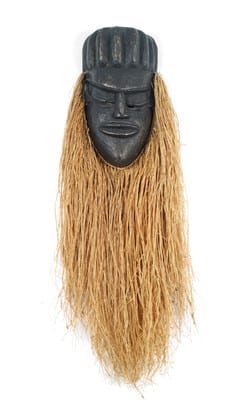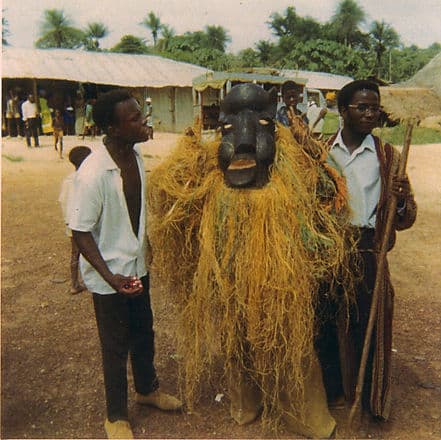Presented by Museum of the Peace Corps Experience and American University Museum
Mende people, c. 1970
Kenema, Eastern Province, Sierra Leone
Blackened cottonwood, raffia fringe,
37 x 20 x 5 in.
Collection, Museum of the Peace Corps Experience
Gift of Michael Colombo, Sierra Leone, Bunumbu 1969–70

After two months of training, I was sent to the Eastern Province of Sierra Leone to the small village of Bunumbu, with a population of about 200 people. I was considered suitable as an agricultural development worker because of my experience with home gardening.
It was not long before I found out that the villagers weren’t really interested in learning new farming techniques. They were used to the way they had been farming and weren’t about to change. Instead, I learned that a top priority for them was to get fresh, clean drinking water. I helped to procure pumps from the American Embassy and CARE, then helped to install them over existing wells where water was being pulled up by hand.
Our next project was to create a new gravity-feed water system in the next town over. We met with town leaders, and with help from every able-bodied person in the area, we built a dam and a reservoir, then laid a two-inch pipe stretching a half-mile to the village of Pejewa. It took us about a year to complete.
The devil’s mask has been used by the Mende people in Sierra Leone for thousands of years. I picked up a replica for a few dollars from a marketplace in Kenema, Sierra Leone, as the real masks are only worn by devil dancers. Devil dancing is a common feature of ceremonies, such as weddings, funerals, and the Islamic feast of Ramadan. These dancers are men from the Poro Society, a secretive social group common in Liberia, Ghana, Ivory Coast, and Sierra Leone.
The typical devil dancer is dressed from head to toe with raffia palm straw and the devil’s mask on his head. At a ceremony I attended, while the devil danced and spun around to the rhythm of the drums, women and children would taunt him and strike at the straw with their hands. The dancer would try to grab the arm of one of the menacing pranksters and knock them to the ground. Being caught by the devil scared the hell out of the mischief makers, who ran away as fast as they could. These escapades would cause the crowd to roar with laughter.
When the new gravity-feed water system was complete, the town celebrated. A cow was butchered to supply food for the celebration. The sound of drums filled the air, along with the sounds of people dancing, laughing, and telling stories about their ancestors. The event required two devil dancers to match the joy of the occasion.

Museum of the Peace Corps Experience
PO Box 2427
Oregon City, OR 97045
USA
The Committee for a Museum of the Peace Corps Experience is a 501(c)(3) private nonprofit organization. Tax ID: EIN # 93-1289853
The Museum is not affiliated with the U.S. Peace Corps and not acting on behalf of the U.S. Peace Corps.
Museum of the Peace Corps Experience © 2024. All Rights Reserved.